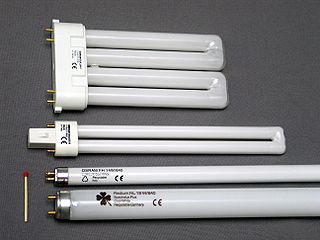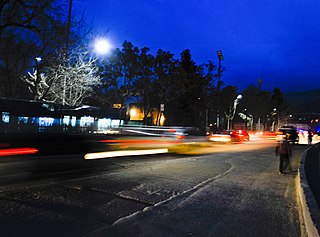Related Research Articles

An electric light is a device that produces visible light from electric current. It is the most common form of artificial lighting and is essential to modern society, providing interior lighting for buildings and exterior light for evening and nighttime activities. In technical usage, a replaceable component that produces light from electricity is called a lamp. Lamps are commonly called light bulbs; for example, the incandescent light bulb. Lamps usually have a base made of ceramic, metal, glass, or plastic, which secures the lamp in the socket of a light fixture. The electrical connection to the socket may be made with a screw-thread base, two metal pins, two metal caps or a bayonet cap.

An incandescent light bulb, incandescent lamp or incandescent light globe is an electric light with a wire filament heated until it glows. The filament is enclosed in a bulb to protect the filament from oxidation. Current is supplied to the filament by terminals or wires embedded in the glass. A bulb socket provides mechanical support and electrical connections.

Lighting or illumination is the deliberate use of light to achieve practical or aesthetic effects. Lighting includes the use of both artificial light sources like lamps and light fixtures, as well as natural illumination by capturing daylight. Daylighting is sometimes used as the main source of light during daytime in buildings. This can save energy in place of using artificial lighting, which represents a major component of energy consumption in buildings. Proper lighting can enhance task performance, improve the appearance of an area, or have positive psychological effects on occupants.

A flashlight is a portable hand-held electric light. The source of the light is usually an incandescent light bulb (lamp) or light-emitting diode (LED). A typical flashlight consists of the light source mounted in a reflector, a transparent cover to protect the light source and reflector, a battery, and a switch. These are supported and protected by a case.

Photovoltaics (PV) is the conversion of light into electricity using semiconducting materials that exhibit the photovoltaic effect, a phenomenon studied in physics, photochemistry, and electrochemistry.

A street light, light pole, lamppost, street lamp, light standard or lamp standard is a raised source of light on the edge of a road or path. When urban electric power distribution became ubiquitous in developed countries in the 20th century, lights for urban streets followed, or sometimes led.

A compact fluorescent lamp (CFL), also called compact fluorescent light, energy-saving light and compact fluorescent tube, is a fluorescent lamp designed to replace an incandescent light bulb; some types fit into light fixtures designed for incandescent bulbs. The lamps use a tube which is curved or folded to fit into the space of an incandescent bulb, and a compact electronic ballast in the base of the lamp.
Street lighting in the United States was introduced to the US by inventor Benjamin Franklin, who was the postmaster of Philadelphia, Pennsylvania. For this reason, many regard Philadelphia as the birthplace of street lighting in the US.

Architectural lighting design is a field within architecture, interior design and electrical engineering that is concerned with the design of lighting systems, including natural light, electric light, or both, to serve human needs.

Reflective surfaces can deliver high solar reflectance and high thermal emittance. Reflective surfaces are a form of geoengineering.

Light tubes are physical structures used for transmitting or distributing natural or artificial light for the purpose of illumination, and are examples of optical waveguides.
Grow lights either attempt to provide a light spectrum similar to that of the sun, or to provide a spectrum that is more tailored to the needs of the plants being cultivated. Outdoor conditions are mimicked with varying colour, temperatures and spectral outputs from the grow light, as well as varying the intensity of the lamps. Depending on the type of plant being cultivated, the stage of cultivation, and the photoperiod required by the plants, specific ranges of spectrum, luminous efficacy and color temperature are desirable for use with specific plants and time periods.

An LED lamp or LED light bulb is an electric light for use in light fixtures that produces light using one or more light-emitting diodes (LEDs). LED lamps have a lifespan many times longer than equivalent incandescent lamps, and are significantly more efficient than most fluorescent lamps, with some LED chips able to emit up to 303 lumens per watt. However, LED lamps require an electronic LED driver circuit when operated from mains power lines, and losses from this circuit means that the efficiency of the lamp is lower than the efficiency of the LED chips it uses. The most efficient commercially available LED lamps have efficiencies of 200 lumens per watt (Lm/W). The LED lamp market is projected to grow by more than twelve-fold over the next decade, from $2 billion in the beginning of 2014 to $25 billion in 2023, a compound annual growth rate (CAGR) of 25%. As of 2016, many LEDs use only about 10% of the energy an incandescent lamp requires.

Efficient energy use, sometimes simply called energy efficiency, is the goal to reduce the amount of energy required to provide products and services. For example, insulating a home allows a building to use less heating and cooling energy to achieve and maintain a comfortable temperature. Installing LED lighting, fluorescent lighting, or natural skylight windows reduces the amount of energy required to attain the same level of illumination compared to using traditional incandescent light bulbs. Improvements in energy efficiency are generally achieved by adopting a more efficient technology or production process or by application of commonly accepted methods to reduce energy losses.

A solar lamp also known as solar light or solar lantern, is a lighting system composed of a LED lamp, solar panels, battery, charge controller and there may also be an inverter. The lamp operates on electricity from batteries, charged through the use of solar photovoltaic panel.

Since their introduction as a commercial product in 1939, many different types of fluorescent lamp have been introduced. Systematic nomenclature identifies mass-market lamps as to overall shape, power rating, length, color, and other electrical and illuminating characteristics.

Solar Electric Power Company is a manufacturer of solar lighting and remote solar power stations that utilize compact fluorescent lamps CFL, light emitting diodes LED, metal halide, induction, low pressure sodium, and high pressure sodium and is based in Stuart, Florida. Steve Robbins, the founder and president, designed and patented the first commercial solar street light.

Solar powered flashlights or solar powered torches are flashlights powered by solar energy stored in rechargeable batteries. Most of these flashlights use light-emitting diodes lamps since they have lower energy consumption compared to incandescent light bulbs.

Solar street lights are raised light sources which are powered by solar panels generally mounted on the lighting structure or integrated into the pole itself. The solar panels charge a rechargeable battery, which powers a fluorescent or LED lamp during the night.

Energy Efficiency Services Limited (EESL) is an energy service company (ESCO) of the Government of India and is the world's largest public ESCO. It is 100% government owned, a joint venture of state-owned NTPC Limited, Power Finance Corporation, Rural Electrification Corporation and POWERGRID. EESL was formed under India's Ministry of Power to facilitate energy efficiency projects. Innovative business and implementation models can significantly reduce consumption and costs. EESL also acts as the resource centre for capacity building of state electricity distribution companies, electricity regulatory commissions (ERCs), state-designated agencies (SDAs), upcoming ESCOs, financial institutions, etc.
References
- ↑ "Archived copy". Archived from the original on 2006-05-15. Retrieved 2006-05-12.CS1 maint: archived copy as title (link)
- ↑ "Archived copy". Archived from the original on 2007-03-15. Retrieved 2006-05-12.CS1 maint: archived copy as title (link)